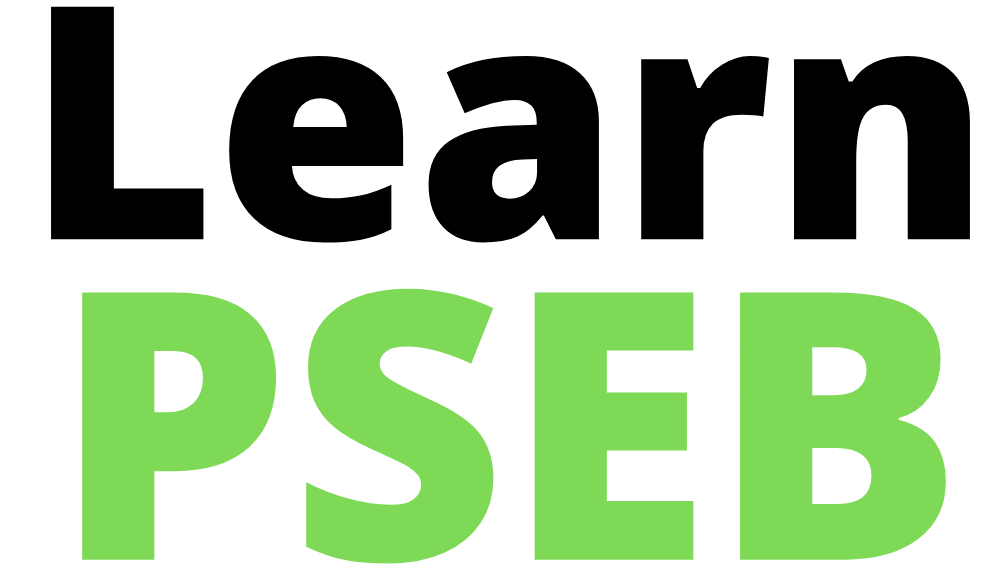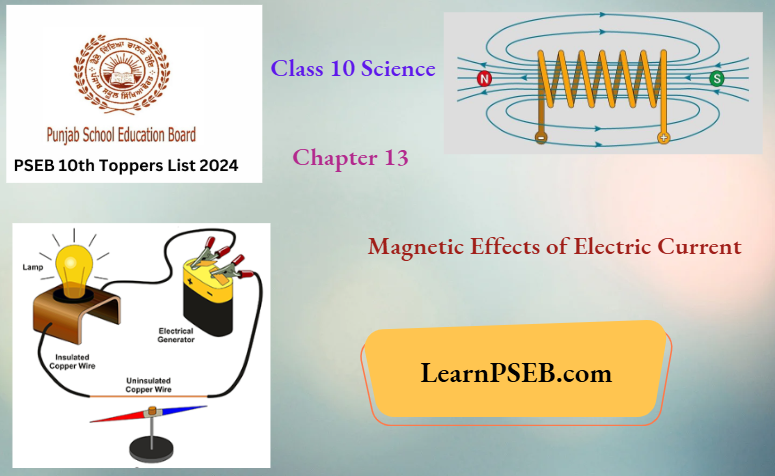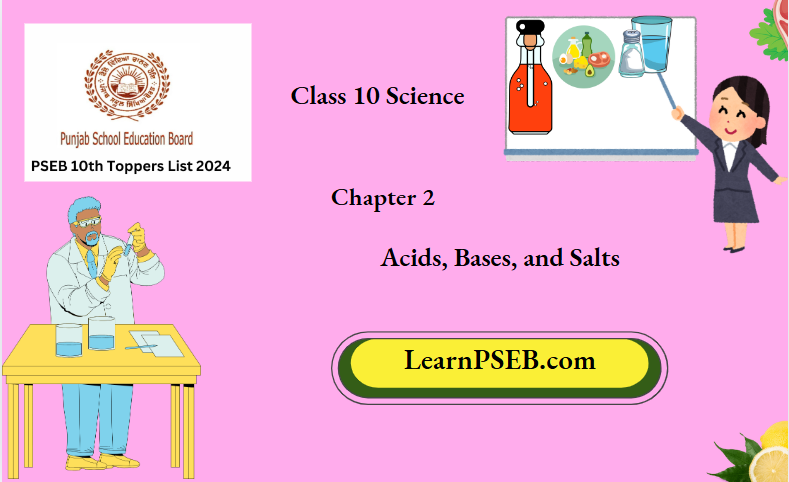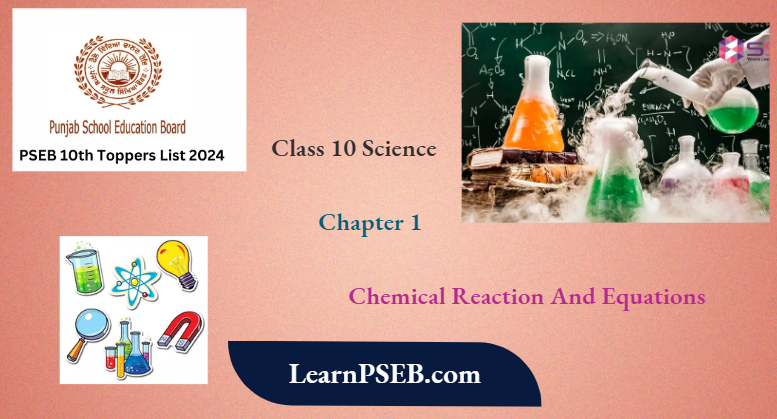
Class 10 Science
PSEB 10th Class Science Solutions For Chapter 13 – Magnetic Effects of Electric Current
PSEB 10th Class Science Solutions: Chapter 13 – Magnetic Effects of Electric Current
Understanding the Magnetic Effects of Electric Current is essential for students in the PSEB 10th class. This chapter covers various concepts related to electromagnetism, including magnetic fields, electromagnetic induction, and electric motors. Here, we present 17 previous year questions and answers that will help students prepare effectively for their exams.
PSEB 10th Class Science Solutions For Chapter 13 Key Concepts
Before diving into the questions, let’s summarize some key concepts:
- Magnetic Field: The region around a magnet where magnetic forces can be observed.
- Electromagnetism: The interaction between electricity and magnetism.
- Electromagnetic Induction: The process of generating electric current from a changing magnetic field.
PSEB 10th Class Science Solutions Chapter 13
Read And Learn More 10th Class Science Solutions
PSEB 10th Class Science Previous Year Questions and Answers
Question 1: What is a magnetic field?
Answer: A magnetic field is a region around a magnet where magnetic forces can be experienced. It is represented by magnetic field lines that indicate the direction and strength of the field.
Question 2: State Fleming’s Left-Hand Rule
Answer: Fleming’s Left-Hand Rule states that if you arrange your thumb, forefinger, and middle finger of your left hand perpendicular to each other, then:
- The thumb points in the direction of the force (motion).
- The forefinger points in the direction of the magnetic field.
- The middle finger points in the direction of the current.
Question 3: What happens when a current-carrying conductor is placed in a magnetic field?
Answer: A current-carrying conductor experiences a force when placed in a magnetic field. The direction of this force can be determined using Fleming’s Left-Hand Rule.
Question 4: Describe electromagnetic induction
Answer: Electromagnetic induction is the process of producing an electric current in a coil due to a changing magnetic field around it. This occurs when there is relative motion between a magnet and the coil.
Question 5: What is an electric motor?
Answer: An electric motor is a device that converts electrical energy into mechanical energy using the principle of electromagnetism. It operates based on the forces acting on current-carrying conductors placed in a magnetic field.
Magnetic Effects of Electric Current PSEB 10th Class Notes
Question 6: How does the strength of a magnetic field change with distance from a current-carrying wire?
Answer: The strength of the magnetic field decreases as you move away from a current-carrying wire. It is strongest at the wire and diminishes with distance.
Question 7: What is the right-hand thumb rule?
Answer: The right-hand thumb rule states that if you hold a current-carrying conductor with your right hand such that your thumb points in the direction of current flow, then your curled fingers will indicate the direction of the magnetic field lines around the conductor.
Question 8: Explain how to increase the strength of an electromagnet.
Answer: To increase the strength of an electromagnet, you can:
- Increase the number of turns in the coil.
- Increase the current flowing through the coil.
- Use a core material with higher magnetic permeability, such as iron.
Question 9: What is meant by “magnetic lines of force”?
Answer: Magnetic lines of force are imaginary lines that represent the direction and strength of a magnetic field. They emerge from the north pole and enter at the south pole, forming closed loops.
Question 10: How do you determine whether an induced current flows clockwise or counterclockwise?
Answer: The direction of induced current can be determined using Lenz’s Law, which states that induced current flows in such a direction as to oppose the change causing it. You can also use Fleming’s Right-Hand Rule for this purpose.
PSEB 10th Class Science Important Questions Chapter 13
Question 11: What are solenoids?
Answer: A solenoid is a long coil of wire that creates a uniform magnetic field when an electric current passes through it. Solenoids can act as electromagnets when energized.
Question 12: How does increasing current affect the force on a conductor in a magnetic field?
Answer: Increasing the current flowing through a conductor increases the force experienced by that conductor when placed in a magnetic field. This relationship is directly proportional.
Question 13: What factors affect electromagnetic induction?
Answer: The factors affecting electromagnetic induction include:
- The strength of the magnetic field.
- The speed at which the magnet moves relative to the coil.
- The number of turns in the coil.
Question 14: Explain why two coils placed close to each other can induce current in one another.
Answer: When one coil carries an alternating current, it generates a changing magnetic field. This changing magnetic field can induce an electromotive force (emf) and thus an induced current in another nearby coil due to electromagnetic induction.
Question 15: What are some applications of electromagnetic induction?
Answer: Applications include:
- Electric generators.
- Transformers.
- Induction cooktops.
- Magnetic levitation trains.
Question 16: How does an electric generator work?
Answer: An electric generator works on the principle of electromagnetic induction. When a coil rotates within a magnetic field, an emf is induced across its ends, generating electric current.
PSEB 10th Class Physics Chapter 13 Solutions
Question 17: Describe how to demonstrate that electric currents produce magnetic fields.
Answer: You can demonstrate this by performing an experiment where you pass an electric current through a straight wire and place a compass nearby. The compass needle will deflect, indicating that a magnetic field has been created around the wire due to electric current flow.
PSEB 10th Class Science Chapter 13 Conclusion
Studying Chapter 13 on Magnetic Effects of Electric Current is vital for students preparing for their PSEB Class 10 exams. By reviewing these previous year questions and answers, students can enhance their understanding and boost their confidence for upcoming assessments.
PSEB 10th Class Science Solutions For Chapter 2 – Acids, Bases, and Salts
PSEB 10th Class Science Solutions: Chapter 2 – Acids, Bases, and Salts
In the PSEB 10th Class Science curriculum, Acids, Bases, and Salts is crucial for understanding the properties and reactions of these substances. This article provides previous year questions and answers to help students prepare effectively for their exams.
PSEB 10th Class Science Solutions Chapter 2
PSEB 10th Class Science Chapter 2 Key Concepts in Acids, Bases, and Salts
Before diving into the questions, let’s briefly summarize the essential concepts:
- Acids: Substances that release hydrogen ions (H⁺) in aqueous solutions. Common examples include hydrochloric acid (HCl) and sulfuric acid (H₂SO₄).
- Bases: Substances that release hydroxide ions (OH⁻) in solution. Sodium hydroxide (NaOH) is a typical base.
- Salts: Formed when an acid reacts with a base, resulting in a neutralization reaction.
Acids, Bases, and Salts PSEB 10th Class Notes
Read And Learn More 10th Class Science Solutions
PSEB 10th Class Science Chapter 2 Previous Year Questions and Answers
Question 1: What is the pH of a neutral solution?
Answer: The pH of a neutral solution is 7. This indicates that the concentration of hydrogen ions (H⁺) is equal to that of hydroxide ions (OH⁻).
Question 2: Why do HCl and HNO₃ show acidic behavior in aqueous solutions while glucose does not?
Answer: HCl and HNO₃ dissociate in water to release H⁺ ions, which are responsible for acidity. In contrast, glucose does not dissociate to release H⁺ ions in solution; hence, it does not exhibit acidic behavior.
Question 3: Describe the reaction between an acid and a metal carbonate.
Answer: When an acid reacts with a metal carbonate, it produces a salt, water, and carbon dioxide gas. For example:
Question 4: What happens when an acid reacts with a base?
Answer: The reaction between an acid and a base is called neutralization. It produces salt and water. For example:
Question 5: How can you identify an acidic solution using litmus paper?
Answer: An acidic solution turns blue litmus paper red. If you have red litmus paper, it will remain red in an acidic solution.
PSEB 10th Class Science Important Questions Chapter 2
PSEB 10th Class Science Study Tips for Chapter 2
- Understand Key Definitions: Familiarize yourself with definitions of acids, bases, and salts.
- Practice Reactions: Write out the chemical equations for reactions involving acids and bases.
- Use Visual Aids: Diagrams that illustrate pH scales or reaction processes can enhance understanding.
- Solve Previous Year Papers: Regularly practice with past exam questions to improve your problem-solving skills.
PSEB 10th Class Chemistry Chapter 2 Solutions
PSEB 10th Class Science Solutions For Chapter 2 Conclusion
Mastering Chapter 2 on Acids, Bases, and Salts is essential for success in the PSEB 10th Class Science exam. By reviewing previous year questions and their answers, students can solidify their understanding of key concepts and enhance their exam preparation strategies.
PSEB 10th Class Science Solutions For Chapter 1 Chemical Reactions and Equations
PSEB 10th Class Science Solutions: Chapter 1 – Chemical Reactions and Equations
Understanding the fundamentals of Chemical Reactions and Equations is essential for students in the PSEB 10th class. This chapter lays the groundwork for many concepts in chemistry, making it crucial for both examinations and practical applications. In this article, we will explore key topics from this chapter, provide solutions to important questions, and offer tips for mastering the content.
PSEB 10th Class Science Solutions Chapter 1
Key Concepts in Chemical Reactions
Chemical Reactions involve the transformation of reactants into products through various processes. Here are some essential concepts covered in Chapter 1:
- Definition of Chemical Reactions: A chemical reaction occurs when substances undergo a change to form new substances. This can involve changes in physical properties, energy changes, and the formation of new compounds.
- Types of Chemical Reactions:
- Combination Reactions: Two or more reactants combine to form a single product.
- Decomposition Reactions: A single compound breaks down into two or more simpler substances.
- Displacement Reactions: An element displaces another in a compound.
- Redox Reactions: Involves the transfer of electrons between substances.
- Balancing Chemical Equations: It is crucial to balance chemical equations to obey the law of conservation of mass. This means that the number of atoms of each element must be equal on both sides of the equation.
Read And Learn More 10th Class Science Solutions
Chemical Reactions and Equations PSEB 10th Class Notes
PSEB 10th Class Science Solutions For Chapter 1 Chemical Reactions and Equations
To aid students in their preparation, here are solutions to some common questions from this chapter:
- Question: Write a balanced equation for the reaction between hydrogen and oxygen to form water.
- Solution:
- Solution:
- Question: Identify whether the following reaction is a combination or decomposition reaction:
.
- Solution: This is a combination reaction, as two reactants (sodium and chlorine) combine to form a single product (sodium chloride).
- Question: What is meant by a redox reaction? Provide an example.
- Solution: A redox reaction involves both oxidation (loss of electrons) and reduction (gain of electrons). For example:
In this reaction, zinc is oxidized while copper ions are reduced.
- Solution: A redox reaction involves both oxidation (loss of electrons) and reduction (gain of electrons). For example:
PSEB 10th Class Science Important Questions Chapter 1
PSEB 10th Class Science Solutions Tips for Mastering Chemical Reactions
- Practice Balancing Equations: Regularly practice balancing different types of chemical equations to gain confidence.
- Use Visual Aids: Diagrams and flowcharts can help visualize complex reactions and processes.
- Group Study: Discussing concepts with peers can enhance understanding and retention.
- Utilize Online Resources: Many educational platforms offer free resources, including videos and interactive quizzes, that can supplement your learning.
PSEB 10th Class Chemistry Chapter 1 Solutions
PSEB 10th Class Science Solutions Conclusion
Mastering Chapter 1 on Chemical Reactions and Equations is vital for success in PSEB 10th Class Science. By understanding key concepts, practicing solutions, and utilizing effective study strategies, students can enhance their comprehension and performance in chemistry. For further practice, consider downloading additional resources or solutions available online that align with your curriculum.
Punjab State Board Life Processes Class 10 Science Question and Answers
Punjab State Board Class 10 Biology Chapter Life Processes Question and Answers
Question 1. What is translocation? How does it take place in plants?
Answer:
Translocation
Translocation is the transport of food and other solutes in the phloem of plants. It occurs from the region of manufacture or storage to the area of consumption in a mass flow due to the development of a turgor gradient.
Question 2. Leakage from blood vessels reduces the efficiency of the pumping system. How is leakage prevented?
Answer:
Leakage from blood vessels reduces the efficiency of the pumping system
In the area of leakage, blood platelets burst to release thromboplastin. It helps in the formation of a fibrin network in which blood cells accumulate to seal the area.
Read And Learn More 10th Class Science Solutions
Question 3. Mention the two main components of the transport system in plants. State one function of each.
Answer:
The two main components of the transport system in plants
- Plants have two components in their transport system, the xylem and phloem. Xylem transports sap (water and minerals) by means of its tracheary elements of vessels and tracheids.
- The movement is unidirectional from root to aerial parts. Phloem transports food by means of its sieve tubes both in the upward and downward directions.
Punjab State Board Life Processes Class 10 Science
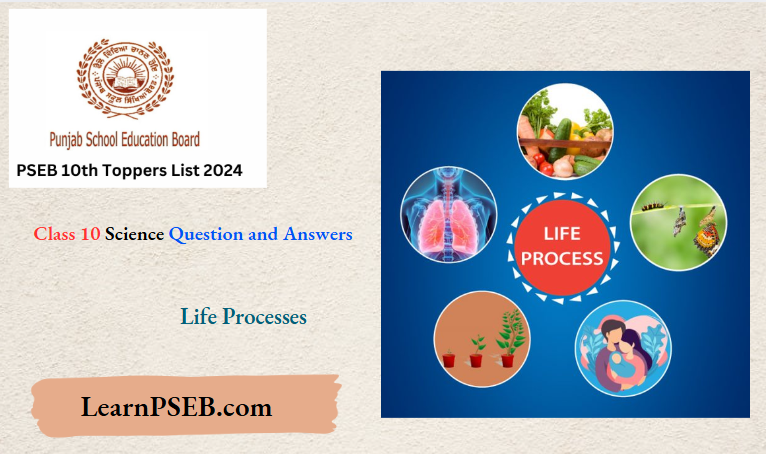
Question 4. Give reason :
- Ventricles have thicker walls than the atria
- Capillaries have one-cell thick walls.
Answer:
- Atria receive blood from veins and pump the same in two adjacent ventricles. Ventricles have to pump blood forcefully in order to send it to different parts of the body.
- Capillaries are meant for the exchange of materials between tissue fluid and blood.
Question 5. How are O2 and CO2 transported in human beings?
Answer:
Both are transported through blood. Oxygen travels in a combined form with haemoglobin as oxyhaemoglobin. Carbon dioxide is transported both in plasma (77%) as well as combined with haemoglobin (23%).
Punjab State Board Life Processes Class 10 Science
Question 6.
- What is the role of fibrinogen?
- How is blood clotting useful?
Answer:
- Fibrinogen terms insoluble fibrin that polymerises and produces a network as the base of blood clots.
- It seals the place of injury in the blood vessel. As a result, blood loss from the injured blood vessel stops.
Question 7. What do you mean by double circulation? Why is it necessary?
Answer:
Double circulation
Double circulation is the passage of the same blood twice through the heart in order to complete one circulation. One step is the passage of deoxygenated blood from the right ventricle to the lungs and the return of oxygenated blood to the left auricle.
The second is the pumping of oxygenated blood to the rest of the body and the return of deoxygenated blood to the right auricle.
PSEB Class 10 Science Chapter 1 Life Processes Solutions
Importance.
- It provides for thorough oxygenation of the whole deoxygenated blood in the lungs.
- It ensures the supply of completely oxygenated blood to all body parts for their efficient working and thermoregulation.
Punjab State Board Question 8. List three kinds of blood vessels and their functions.
Answer:
Capillaries, arteries and veins.
Capillaries.
- Exchange of materials between blood and tissue fluid.
- Filtering out tissue fluid.
- Diapedesis for killing germs.
Artery,
- Supply of oxygenated blood to all body parts
- Sending deoxygenated blood to lungs for oxygenation
Veins.
- Carrying deoxygenated blood from various body parts to the heart.
- Carrying of oxygenated blood from lungs to heart.
Punjab State Board Life Processes Class 10 Science
Question 9.
- What is the composition of blood?
- How are oxygen and carbon dioxide transported in our bodies?
Answer:
- Composition of Blood. Plasma (55%) and blood cells (45%). Blood cells are of three types—erythrocytes, leucocytes and blood platelets.
- Oxygen is transported as oxyhaemoglobin (97%) and a small quantity dissolved in plasma.
- Carbon dioxide is transported as carbaminohaemoglobin (23%), bicarbonate (70%) and carbonic acid (7%) in plasma.
Life Processes Class 10 Question and Answers PSEB
Question 10. What is translocation? Why is it essential for plants? Where are the substances translocated by phloem delivered?
Answer:
Translocation
Translocation. It is the passage of food and other solutes from the region of their source to the region of their sink or utilisation.
- Requirement. Every cell requires food for its subsistence while food is available only from the region of manufacture and storage.
- Delivery. Though every cell requires food, the major areas of delivery of food materials are growing regions, growing fruits and storage regions.
Question 11. Explain why is transportation of materials is necessary in animals.
Answer:
Animals have specialised regions for digestion of food, exchange of gases and elimination of wastes.
- However, every cell of the body requires food materials and oxygen. It also produces carbon dioxide and wastes.
- Therefore, a transport system (blood circulatory system) is required to pick up nutrients from the digestive tract, oxygen from the lungs, and hormones from endocrine glands for supply to cells.
- The transport system also collects carbon dioxide and wastes to take them to the lungs and kidneys.
Question 12. Give one function each of
- Blood vessels
- Lymph and
- Heart.
Answer:
- Blood Vessels. Transport of blood from heart to body parts and back, exchange of materials between blood and tissue fluid in the region of capillaries.
- Lymph. It collects extra tissue fluid, secretions and excretions from the tissues for pouring into blood.
- Heart. It pumps oxygenated blood to different body parts and deoxygenates to the lungs.
PSEB Class 10 Biology Life Processes Notes
Question 13. Write three types of blood vessels. Give one important feature of each.
Answer:
Three types of blood vessels
The three types of blood vessels are capillaries, arteries and veins.
- Capillaries. Very fine tubes with walls made of single layers of cells. They are specialised in exchanging materials with tissue fluid.
- Arteries. They have thick elastic walls with narrow lumen. Arteries carry blood away from the heart. They usually possess oxygenated blood, except for pulmonary arteries.
- Veins. They have thin walls, and internal valves, with wide lumen carrying usually deoxygenated blood towards the heart, except pulmonary veins.
Question 14. Define the term transpiration. Design an experiment to demonstrate this process.
Answer:
Transpiration
Transpiration is the loss of water in vapour form from the aerial parts of the plants.
Experiment.
- Take a well-watered potted plant,
- Cover it shoot system with a transparent polythene sheet. Tie the edges of the sheet properly with thread.
- Place the apparatus in bright sunlight for 30-45 minutes,
- Observe the appearance of water droplets on the inner side of the polythene covering,
- Apparently, the shoot has lost water in vapour form which has condensed.
Question 15. What is transpiration? List its two functions.
Answer:
Transpiration. It is the loss of water in vapour form from the aerial parts of the plants.
Functions.
- Transpiration creates a force for absorption and ascent of water.
- It prevents overheating of plants exposed to strong sunlight.
Question 16. List two types of transport systems in human beings and write the functions of any one of them.
Answer:
Blood circulatory system and lymphatic system.
Functions of Blood Circulatory System.
- Transport of oxygen.
- Transport of carbon dioxide.
- Transport of digested food.
- Transport of waste products.
- Transport of hormones.
- Transport of salts.
- Plugging place of injury.
- Protection from pathogens.
Functions of Lymphatic System.
- Transport of digested fat from the intestine and later passage into the blood.
- It maintains blood volume by draining extra tissue fluid and passing it into the blood.
Punjab Board Class 10 Science Chapter 1 Solutions
Question 17. List four functions of the human heart. Why is double circulation necessary in the human body?
Answer:
Functions of Heart.
- Receiving deoxygenated blood from various parts of the body in the right auricle.
- Pumping the deoxygenated blood into the lungs for oxygenation.
- Receiving oxygenated blood from lungs in left auricle.
- Pumping the oxygenated blood to all parts of the body.
Double Circulation. It is the passage of the same blood twice through the heart, once for complete oxygenation and afterwards supply of pure oxygenated blood to all parts human of the body. It meets the high energy requirement of the body for thermoregulation and high activity.
Question 18. What is haemoglobin? State the consequences of deficiency of haemoglobin in our bodies.
Answer:
Haemoglobin
- Haemoglobin is a respiratory pigment of the body. It is present inside the red blood corpuscles. Haemoglobin combines with oxygen to form oxyhaemoglobin. As oxyhaemoglobin, it reaches all parts of the body.
- Oxygen separates from haemoglobin and diffuses into the tissue fluid and then into living cells where it is being consumed in respiration. Haemoglobin also carries a smaller amount of carbon dioxide from tissues to the lungs.
- Deficiency. A deficiency of haemoglobin, also called anaemia results in less supply of oxygen to tissues that produce lesser energy so that all activities of the body slow down.
